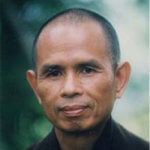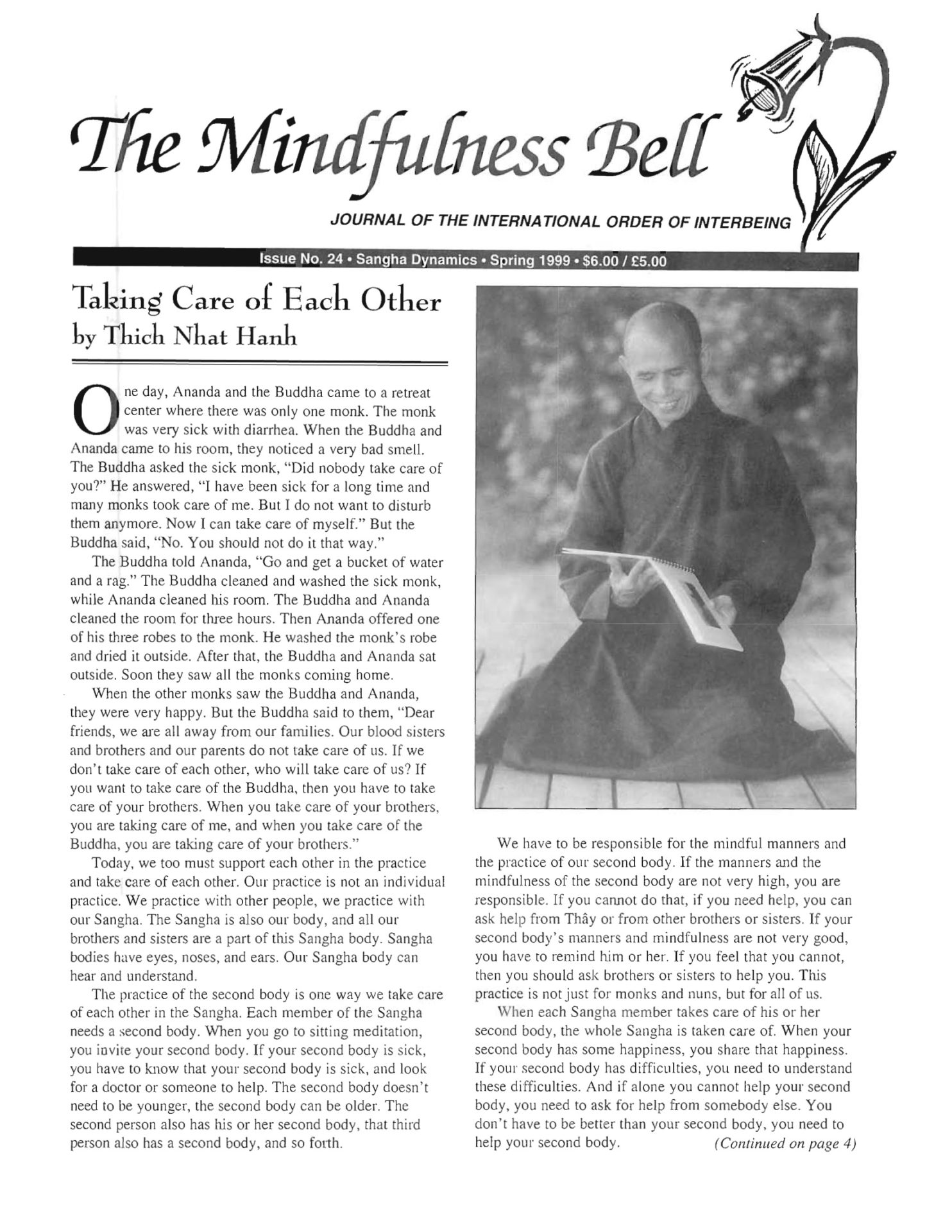By Thich Nhat Hanh in March 1999
One day, Ananda and the Buddha came to a retreat center where there was only one monk. The monk was very sick with diarrhea. When the Buddha and Ananda came to his room, they noticed a very bad smell. The Buddha asked the sick monk, “Did nobody take care of you?” He answered, “I have been sick for a long time and many monks took care of me.
By Thich Nhat Hanh in March 1999
One day, Ananda and the Buddha came to a retreat center where there was only one monk. The monk was very sick with diarrhea. When the Buddha and Ananda came to his room, they noticed a very bad smell. The Buddha asked the sick monk, "Did nobody take care of you?" He answered, "I have been sick for a long time and many monks took care of me. But I do not want to disturb them anymore. Now I can take care of myself." But the Buddha said, "No. You should not do it that way."

The Buddha told Ananda, "Go and get a bucket of water and a rag." The Buddha cleaned and washed the sick monk, while Ananda cleaned his room. The Buddha and Ananda cleaned the room for three hours. Then Ananda offered one of his three robes to the monk. He washed the monk's robe and dried it outside. After that, the Buddha and Ananda sat outside. Soon they saw all the monks coming home.
When the other monks saw the Buddha and Ananda, they were very happy. But the Buddha said to them, "Dear friends, we are all away from our families. Our blood sisters and brothers and our parents do not take care of us. If we don't take care of each other, who will take care of us? If you want to take care of the Buddha, then you have to take care of your brothers. When you take care of your brothers, you are taking care of me, and when you take care of the Buddha, you are taking care of your brothers."
Today, we too must support each other in the practice and take care of each other. Our practice is not an individual practice. We practice with other people, we practice with our Sangha. The Sangha is also our body, and all our brothers and sisters are a part of this Sangha body. Sangha bodies have eyes, noses, and ears. Our Sangha body can hear and understand.
The practice of the second body is one way we take care of each other in the Sangha. Each member of the Sangha needs a second body. When you go to sitting meditation, you invite your second body. If your second body is sick, you have to know that your second body is sick, and look for a doctor or someone to help. The second body doesn't need to be younger, the second body can be older. The second person also has his or her second body, that third person also has a second body, and so forth.
We have to be responsible for the mindful manners and the practice of our second body. If the manners and the mindfulness of the second body are not very high, you are responsible. If you cannot do that, if you need help, you can ask help from Thay or from other brothers or sisters. If your second body's manners and mindfulness are not very good, you have to remind him or her. If you feel that you cannot, then you should ask brothers or sisters to help you. This practice is not just for monks and nuns, but for all of us.
When each Sangha member takes care of his or her second body, the whole Sangha is taken care of. When your second body has some happiness, you share that happiness. If your second body has difficulties, you need to understand these difficulties. And if alone you cannot help your second body, you need to ask for help from somebody else. You don't have to be better than your second body, you need to help your second body.
Practicing like this, you will see a miraculous result. You are responsible for everything that happens to your second body. When you take care of your second body, your third, fourth, and fifth bodies are also taken care of. Taking care of your second body, you take care of everybody else.
We may have a second body who feels difficult to look after. Perhaps the people we think would be easy to look after have already been taken. The method of getting a second body is this: everybody in turn says the name of the person they want to be their second body. At first, there are many people to choose from, but as we go along perhaps there is only one person left, and we have to choose that person. We may feel that this person is very difficult to look after, but you should know that this is a wonderful opportunity. The person who you think would be difficult can bring you a great deal of benefit and joy in your practice. Some fruits have thorns and are hard, but when we break them open, they taste very good. The monkeys know that—they break open these hard-skinned fruits. There are people we see who from the outside are not very sweet, but if we know how to open them up, the fruit is wonderful. Don't be deceived by the outside. Don't think that the second body is very difficult to look after. Bring all your ability to look after that person and he will become a sweet spring of water.
The practice of the second body is a wonderful Dharma door and we need to succeed in its practice. We should not practice according to the outer form, just saying I have a second body. We should not practice only half-heartedly. With sincere practice, we will have a direct experience of the benefits of the practice.
Another very important practice is Shining Light, offering guidance in the principle of Sangha eyes. The Sangha eyes can see thoroughly. Many people think that the Sangha does not know, but the Sangha knows. It can see much better than you can. This practice comes directly from the tradition that on the last day of the winter retreat (or the rainy season retreat) a monk should bow down in front of his brothers and ask, "Please, with compassion, shine light on me so that I can see my strengths and my weakness during the past three months of this retreat." He must prostrate deeply to receive this guidance. In Plum Village, we have developed this into a practice that is not only used at the end of the winter retreat, but also from time to time, when any of us needs the guidance of the Sangha. We can come forward, make deep prostrations, and ask for guidance. Even a senior teacher, like Sister Annabel Laity, comes to the Sangha from time to time, prostrates, and asks her younger sisters to shine light on her practice. Most of the people who are there, whom she bows before, are her students.
Shining Light practice is a Dharma door which we offer to the Three Jewels and which we will hand on to future generations. We have to do what we can. We have to shine the light with all our compassion and lovingkindness, all our respect and love. We should see the person we are shining light on as ourselves. We haven't the right to hide what we have seen. We have to be sincere in saying what we have seen. This is a method of deep looking. We may need to take time from sitting meditation to look deeply, because sitting meditation and looking deeply are the same. In a session of shining light, we need the same seriousness as we have in meditation. We should sit, body and mind as one, our backs straight, not in a sloppy way. We should shine light, sitting as straight as we do in sitting meditation and with all our heart.
The collective insight of the Sangha is offered in the form of a letter. The letter always begins by mentioning the positive qualities of the person who has asked for guidance to help him or her strengthen his or her self-esteem. The weaknesses of the person concerned will be mentioned after, with details, and then the suggestions to help him or her to practice. All are written with the language of lovingkindness and compassion.
One beautiful autumn day during a retreat at Omega, we were happy to walk in the forest beside trees with all their leaves of different colors. I came to a maple tree and looked deeply at the leaves. I realized that no leaf was perfect. Many leaves had holes or ragged edges. But when I looked at the whole tree, the maple tree was so beautiful. Each leaf has its own position, its own integrity. There are small leaves and big leaves, and the tree is beautiful because of the harmony of all leaves. The leaves on the top were not proud that they were the top leaves, and the leaves at the bottom were not sad that they were at the bottom. All the leaves were very happy with their own positions. The whole tree forms a miracle, and that is the harmony of the tree. Like the leaves, we don't need to be perfect, but when we live together in harmony, our Sangha is beautiful and we don't need to feel bad about ourselves.
Harmony is the practice of the Sangha. If we have harmony, we have happiness. We don't need to be perfect. I myself am not perfect and you too, you don't need to be perfect. But in your own position, if you can express your harmony in the Sangha, this is your beauty. The Sangha of the Buddha is called the Sangha of six harmonies. When the Sangha makes a decision, we first ask, "Has the community assembled in sufficient number?" Then we ask, "Do we have harmony in our community?" If the answer is no, then the decisions are not valid. If you want to build a Sangha, you have to remember that harmony is the basic ingredient.
We need to practice in such a way that there is harmony in our Sangha. Each of us is a younger brother or a big brother, a younger sister or a big sister; each of us has our own position. We are happy in that position, like the maple leaves. When the maple leaves are in their own position, they make the harmony of the whole tree, and when we look at the tree, the tree is so beautiful.


